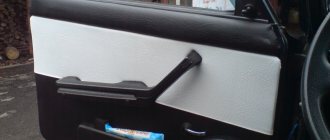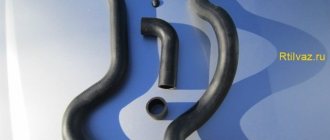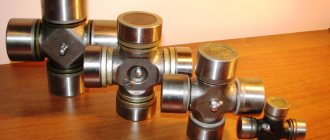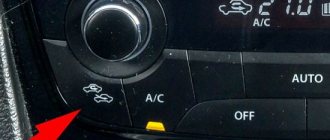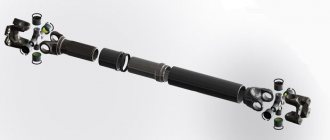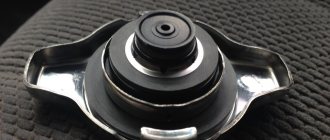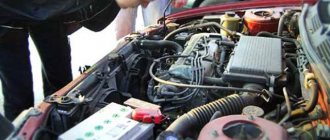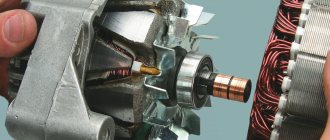The load-bearing part is one of the most important components in the design of a car, because it is thanks to it that it is possible to assemble all the components of the car into a single whole.
Nowadays several types of load-bearing parts are used, each of which has found application on certain types of cars. Initially, all cars were built on the basis of a frame supporting part. But over time, it was replaced by other types, for example, almost all passenger cars use a monocoque body, in which there is no frame, and all its functions are performed by a reinforced body. And yet the frame bearing part continues to be used - on trucks and SUVs.
What is a car frame: purpose, pros and cons
The car frame is a beam structure that acts as the basis for fastening all components and assemblies, such as the power plant, transmission elements, chassis, and so on. The body with this design of the supporting system provides space to accommodate passengers and luggage, and also performs a decorative function.
Car frame
The use of a frame makes it possible to give the load-bearing part high strength. That's why it is used in trucks and SUVs. It also makes it possible to maximize the unification of components and mechanisms between models of different classes.
Previously, car manufacturers produced car chassis with basic parts (frame, engine, transmission, etc.), onto which various types of bodies were “stretched.”
The frame in the car acts as a “skeleton”. It absorbs all external and internal loads when the car is moving and even when it is parked. In view of this, a number of requirements are imposed on the automobile frame:
- sufficient strength and rigidity;
- small weight;
- the correct shape, which will contribute to the rational operation of all elements of the car.
The frame bearing part has a number of advantages. So, thanks to it, assembling the car and repairing it in the future becomes much easier. The main difference between a frame structure and a body structure is that any breakdown can be easily repaired thanks to a good specialist and materials. Another important advantage: driving on bad roads will not be fraught with distortions of the body (door openings, pillars, etc.).
Spar frame
Along with this, there are also disadvantages. The first is a significant increase in the weight of the car due to the presence of a separate frame and body. Accordingly, fuel consumption will also be higher. Another disadvantage is that placing the side members under the body requires additional space, which makes getting into the car difficult and takes up a significant part of the interior.
There is also a decrease in passive safety, since there is a possibility of the frame shifting relative to the body in the event of an impact. Therefore, the load-bearing body is an integral element of a passenger car. At the same time, the frame design copes well with the harsh conditions in which trucks and SUVs drive.
The main advantages of the frame structure
Frame load-bearing frames will not give way to the load-bearing body for a long time, since they have a number of undeniable advantages:
- Simplicity of designs and proven calculation methods.
- Strength. To bend, and even more so, break the frame, a lot of force will be required.
- On passenger cars, the body is attached with elastic fastenings, which increases passenger comfort. To achieve a similar effect in frameless frames, you need to take a number of additional design measures.
- Low torsional resistance. Achieved due to the thickness of the metal of the side members and cross members.
- Increased ground clearance. Bridges are installed on frame structures, allowing for increased cross-country ability.
Truck frame
On one platform you can design different models of cars.
The decisive advantage of the structures is the convenience of major repairs: the frame exists separately, the body is on its own. By removing the top of the car, you gain access to the chassis.
Spar frame
This is the most common type. The frame design includes two power longitudinal beams, which are called spars. They stretch along the body and are connected by crossbars. The beams are made of steel. In order to increase twisting performance, various types of section profiles can be used.
The spars are not necessarily straight - sometimes they have both vertical and horizontal bends. They can be located either parallel to the horizontal plane or at a certain angle, which is typical for SUVs. It is also possible to have different arrangements of the cross members, through which the spars are connected. Today it is the most popular frame design, used in most trucks and SUVs.
This frame is perfect for operating the car on bad roads. It also simplifies the repair and assembly of the car. The disadvantages are that the spars take up a considerable part of the interior and somewhat complicate the landing process.
Types of spar frames
Spar X-shaped
An X-shaped frame is one of the types of spar frames. The peculiarity of its design is that the spars at the front and rear are spread apart, and in the center they are brought together as much as possible. This type is similar in appearance to the “X” beech, which is the reason for its name.
Peripheral
It is a type of spar frames. This type began to be actively used on large European-made passenger cars and “dreadnoughts” from the USA in the 60s. In such frames, the spars are located so widely that during the installation of the body they are located at the sills. This allows the floor level to be significantly lowered, while at the same time reducing the immediate height of the machine.
An important advantage of such a machine is its maximum adaptability to side impacts. However, there is a significant drawback - the frame cannot withstand significant loads, so the car body must have the necessary strength and rigidity.
Material of manufacture
The truck frame takes on up to 10-15% of the total weight. Additionally, during movement, the “skeleton” takes on different types of loads, including torsion and bending. The frame structure must withstand heavy loads and be as light as possible. That is why steel with medium or low carbon content is used in production. The most popular brands are St-08 or St-025.
Additional requirements:
- Possibility of cold/hot welding.
- Optimal ratio of chromium, manganese and other elements to increase strength.
- The thickness of the truck frame steel is 3-8 mm, depending on the type of vehicle and the declared load capacity.
Some car owners decide to increase the frame of their truck.
In this case, it is recommended to use bolted connections, which are more reliable. In this case, the bolts that are used for extension must be hardened. As for welding, it does not provide the necessary reliability.
Spinal frame
This type of frame was developed by representatives and was mainly used for machines produced by it. The main supporting element is a pipe connecting the engine at the front with the transmission elements that are located inside it. Essentially, the pipe acts as a single housing for the gearbox, transfer case and drive shafts. Torque from the engine to the transmission is supplied through a shaft placed in the pipe. Moreover, this shaft is not a cardan shaft, which ensures greater reliability.
Spinal frame
This frame design, combined with independent wheel suspension, provides very long travel, which makes it indispensable in special-purpose vehicles.
The advantage of the backbone frame is also that it has very high torsional rigidity, and the transmission elements are reliably protected from external influences. But due to the fact that certain mechanisms are located inside the frame structure, repair work becomes noticeably more complicated.
Fork-ridge
The fork-spine type of frames is also a Tatra development. In this version, the engine is not mounted to the transmission pipe, but on a special spar fork. This is done in order to reduce the level of transmitted vibrations from the operating internal combustion engine to the frame and, consequently, to the car body. However, today fork-spine frames are no longer used in the automotive industry.
Fork-spine frame
Dimensions of vehicles
Important characteristics of any vehicle (VV) are overall dimensions. These are length, width, height, load capacity, body volume.
In order to correctly determine the dimensions, it is important to clearly understand the terminology and be able to correctly calculate the distance.
Wheelbase is the distance from the center line of the front wheels to the center line of the rear wheels. The standard for small, compact cars is 254 mm (100 inches), for full-size cars and pickups - 381 cm.
Space frame
The most complex type of frame structure used for sports cars. This design is a frame based on thin alloy pipes and has very high rigidity and strength. In the automotive industry, these frames were supplanted by monocoques, however, similar designs are used to create buses.
Space frame
Classification by body type
Sedan. Passenger cars in which the luggage compartment is structurally separated from the passenger compartment. There is no door in the back wall. Most often, sedans are four-door, but there are also two-door (Tudors, for example, Chevrolet Monte Carlo) and five-door models. In the USA, sedans are often called Saloon, in Croatia - Limuzina. Most sedans are hardtops. They do not have central pillars, and there are no outer frames on the side windows.
Load-bearing base
The load-bearing base is something between a body and a frame structure. Spars are also used here, but they are united by a bottom rather than cross members. The most widespread and popular owner of a load-bearing bottom is the Volkswagen Beetle, in which the body is attached to a flat floor panel using bolts. Another mass-produced car, the Renault 4CV, has a similar design.
Load-bearing base
The load-bearing bottom is highly technological and is used in large-scale production. This design makes it possible to make the floor and center of gravity of the car quite low.
The frame load-bearing part of the car has a number of advantages and features that make it indispensable for trucks and SUVs. And although the frame is used purely for specific types of cars, some elements of its design are used extremely widely, as they make it possible to make the load-bearing bodies more rigid. Almost every passenger car is equipped with reinforcing side members or subframes.
Chassis curb weight
Very often you can come across the concepts “curb weight of the chassis”, curb weight of the vehicle.” What is it?
The curb weight of a car is the total weight of the car with all operating materials (full tank of gasoline, coolant, oil). The weight of the driver and passengers is not taken into account. Their mass is taken into account when we are talking about the total mass of the vehicle.
The curb weight of each type of car is different:
- Pickups and SUVs. Weight reaches 2.5 tons.
- Full-size cars, minivans. Weight - about two tons.
- Compact cars. Curb weight – no more than 1360 kg.
- Microcars, microcars. Curb weight is about a ton.
Very often, the curb weight of a vehicle in the characteristics is indicated precisely as the curb weight of the chassis. As a rule, both “Curb chassis weight”, sometimes it indicates “Gross vehicle weight” and “Curb vehicle weight”.
EDUCATION IN MOSCOW
A frame car is the clear choice of most car enthusiasts. What is attractive about a frame car? Types of frames, their advantages and disadvantages. Well, if anyone is not familiar with what a frame on a car is and why it is needed, read this article especially carefully. This is an important characteristic of the car and you need to know it!
What types of car frames are there?
Each car is a collection of mechanical components and assemblies attached to a supporting part. For some cars, the supporting structure (base) is the body , for others it is the frame or subframe .
At the dawn of the automotive industry, frame construction was used on all types of cars. Later, when it became clear that installing the frame was unjustified due to the heavy weight and high cost of manufacturing on passenger cars, they began to use a load-bearing body as a base.
Trucks and off-road vehicles are still equipped with a frame structure today.
The advantage of the frame is that it provides the best rigidity and tensile strength of the structure, torsion, and tension compared to other types of supporting parts. This factor directly affects the vehicle’s carrying capacity and its off-road qualities.
Main types of car frames:
These types have their own varieties. For example, fork-spine refers to spinal frames, peripheral - to spar.
Spar frame
The most common frame design today.
This frame has two longitudinal members and several cross members. The spars are made from a U-shaped profile (channel). The higher the load, the greater the height and thickness of the profile.
Cross members have various design features. There are X- and K-shaped crossbars, as well as straight ones. To install vehicle mechanisms and components on side members and cross members, various fasteners and brackets are used. To fasten frame parts together, rivets, bolts, welds and other connections are used.
Peripheral frame
- differs from a conventional spar in that during manufacture the spars were bent so that there was the greatest distance between them. This is done to ensure that the bottom of the car is as low as possible. Such frames were made and installed on American cars until the 60s of the 20th century.
Spinal frame
In the mid-20s of the last century, the Czechoslovakian developed a spinal frame.
The supporting part is made of a pipe, inside of which all the transmission elements were located. Using this pipe, the engine was connected to the transmission. The power unit, gearbox and final drive, clutch are part of the frame elements. All these elements are rigidly fixed to the frame.
Using a cardan shaft located inside the pipe, the engine transmits torque to the transmission units. Only if all wheels are provided with independent suspension is it possible to install a frame on a car.
Fork-spine frame
- was also invented in the Tatras. The engineers of this company abandoned the rigid fastening of the transmission and engine to the supporting central pipe, as was implemented on the spinal frame. In the new design, special forks appeared on both sides of the supporting pipe, on which the engine and transmission are installed.
The main advantages of the frame structure over others:
- high level of comfort (low noise and vibration),
- high load capacity, simple design
- ease of repair and maintenance, low cost of parts.
Flaws:
- the volume of the car interior decreases,
- greater vehicle weight (increases fuel consumption)
- low passive safety (due to the impossibility of programming crumple zones)
- an increase in the overall price due to the cost of the frame.
Currently, passenger cars are made with a monocoque body, and real (non-SUV) SUVs are made on a frame.
When buying an SUV, you can roughly determine the class of the car by the presence or absence of a frame.
Source
